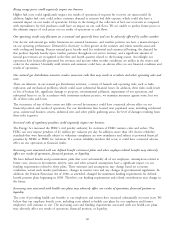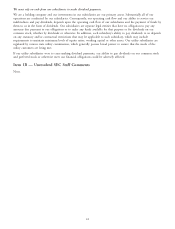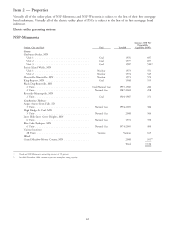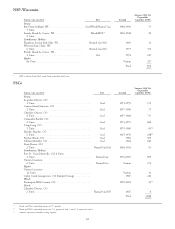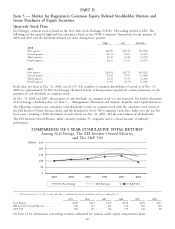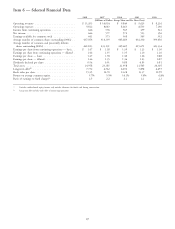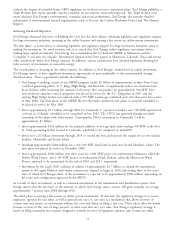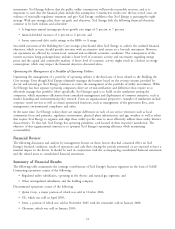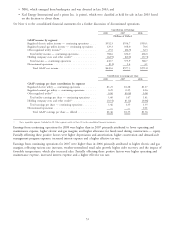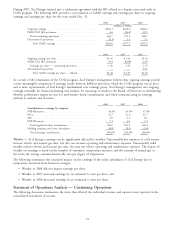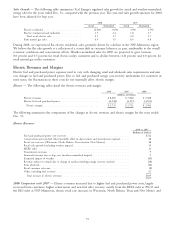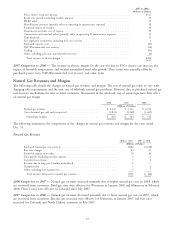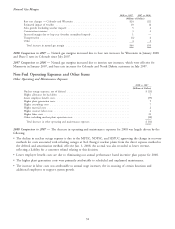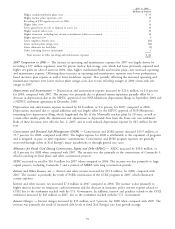Xcel Energy 2008 Annual Report Download - page 60
Download and view the complete annual report
Please find page 60 of the 2008 Xcel Energy annual report below. You can navigate through the pages in the report by either clicking on the pages listed below, or by using the keyword search tool below to find specific information within the annual report.
Greenhouse Gas Emissions
While Xcel Energy is not currently subject to state or federal regulation of its GHG emissions, as one of the nation’s
largest electric generating companies, Xcel Energy is committed to addressing climate change through efforts to reduce
its GHG emissions. This year, Xcel Energy has adopted a new methodology for calculating CO2 emissions based on the
recently issued reporting protocols of The Climate Registry. (Xcel Energy is a ‘‘founding reporter’’ under The Climate
Registry.) Although actual historic emissions from facilities providing power to Xcel Energy customers have not
changed, the new accounting methodology has resulted in an increase in Xcel Energy’s reported CO2 intensity and mass
emission numbers. To enable accurate comparisons and analysis of emissions trends, Xcel Energy has recalculated
historical emissions data to reflect the new accounting methodology. As third-party CO2 reporting protocols continue to
evolve, Xcel Energy expects additional changes in reporting methodology and reported CO2 emissions.
Based on The Climate Registry’s current reporting protocol, Xcel Energy has estimated that its current electric
generating portfolio, which includes coal- and gas-fired plants, emitted approximately 66 million tons of CO2 in 2008.
Xcel Energy has also estimated emissions associated with electricity purchased for resale to Xcel Energy customers from
generation facilities owned by third parties. Xcel Energy estimates that these third-party facilities emitted approximately
21 million tons of CO2 in 2008. Estimated total CO2 emissions, associated with service to Xcel Energy electricity
customers, declined by 3.2 million tons in 2008 compared to 2007, with a combined cumulative reduction of over
21.9 million tons of CO2 since 2003. Xcel Energy anticipates that its ownership share of Comanche 3, a new coal-fired
generation project scheduled for completion in the fall of 2009, will result in CO2 emissions of approximately 762,650
tons in 2009. Thereafter, based on Xcel Energy’s emissions estimates, 3.4 million tons of CO2 per year will be
attributable to Xcel Energy’s ownership share of Comanche 3. Comanche 3, an efficient supercritical pulverized coal
unit, will provide low-cost, base load power and help maintain a reliable, reasonably priced and environmentally sound
electricity supply in Colorado. Operation of Comanche 3 will help support Xcel energy’s efforts to develop renewable
energy, retire older, less-efficient resources and take other steps to reduce emissions across its system. Xcel Energy plans
to implement aggressive clean resource development and conservation plans that will result in overall reductions in Xcel
Energy’s CO2 emissions, both in absolute terms and per Kwh of electricity produced.
State Resource Plans
In 2007, Xcel Energy filed resource plans in Minnesota and Colorado that propose significant new clean energy
resources. During 2008, the Colorado plan was approved substantially as proposed, and the Minnesota plan is still
under review. Under these plans, Xcel Energy would:
• Increase overall system wind capacity from approximately 2,800 MW at the end of 2008 to approximately
7,400 MW by 2020;
• Add between 200 MW and 600 MW of concentrating solar thermal technology;
• Increase the size of our customer energy efficiency and conservation programs, resulting in a reduction of retail
demand;
• Retire and replace several existing coal-fired electric generation facilities;
• Improve the efficiency and reduction of CO2, mercury, SO2 and NOx emissions at several existing fossil plants;
and
• Upgrade the capacity of existing nuclear facilities.
Xcel Energy has designed these plans so that, depending on fuel, commodity and other assumptions, Xcel Energy
would maintain a reasonably priced product and continue to provide reliable power to our customers. At the same
time, if approved, the plans would result in a significant reduction in GHG emissions. The proposed Minnesota plan
would reduce NSP-Minnesota’s CO2 emissions by 22 percent below 2005 levels by 2020. The proposed Colorado plan
would reduce PSCo’s CO2 emissions by 10 percent below 2005 levels by 2017 and position PSCo to propose additional
reductions to achieve a 20 percent reduction by 2020.
Our environmental leadership strategy has resulted in numerous environmental awards and recognition. For example,
Xcel Energy was named to the Dow Jones Sustainability Index for North America for 2008-2009, which was the
second consecutive year that Xcel Energy has earned this distinction. Xcel Energy strives to provide the public with
detailed information regarding environmental performance and risk. Among other things, our utility companies
operating in Minnesota, Colorado, and New Mexico use a carbon proxy cost mandated by the state commissions to
50


